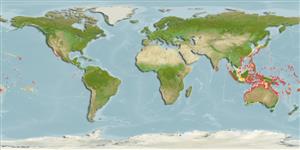Environment: milieu / climate zone / depth range / distribution range
Ecología
marino; salobre asociado a arrecife; rango de profundidad 1 - 40 m (Ref. 34765). Tropical
Pacific Ocean: Indonesia and the Philippines to the Society Islands, north to the Ryukyu Islands, south to the Great Barrier Reef and Fiji.
Tamaño / Peso / Age
Maturity: Lm ? range ? - ? cm
Max length : 25.0 cm TL macho / no sexado; (Ref. 34765); common length : 20.0 cm SL macho / no sexado; (Ref. 37816)
Espinas dorsales (total): 12; Radios blandos dorsales (total): 9; Espinas anales 3; Radios blandos anales: 5. Snout length > orbit diameter. Has a dark purplish blotch on the rear of the spinous dorsal fin (Ref. 37816). Juveniles with large, forward pointing tentacles above the eyes (Ref. 48635). Space on opercle between opercular spines scaled; penultimate dorsal spine 1.9-2.2 in length of last spine; reaches 195 mm SL (rarely over 170 mm) (Ref 42181).
Found in coral and rocky areas to depths over 40 m (Ref. 34765); also in coastal and slopes, estuaries and lagoons, often in algae covered rubble zones (Ref. 48635). Feeds on fishes (Ref. 89972). Solitary and difficult to see due to camouflage colors (Ref 90102).
Life cycle and mating behavior
Madurez | Reproducción | Puesta | Huevos | Fecundidad | Larva
Myers, R.F., 1999. Micronesian reef fishes. A comprehensive guide to the coral reef fishes of Micronesia. Coral Graphics, Barrigada, Guam. 216 p. (Ref. 34765)
IUCN Red List Status (Ref. 130435)
Threat to humans
Harmless
Human uses
Más información
Nombres comunesSinónimosMetabolismoDespredadoresEcotoxicologíaReproducciónMadurezPuestaAgregación para la puestaFecundidadHuevosEgg development
ReferenciasAcuiculturaPerfil de acuiculturaRazasGenéticaElectrophoresesheritabilidadEnfermedadesProcesamientoNutrientsMass conversion
ColaboradoresImágenesStamps, Coins Misc.SonidosCiguateraVelocidadTipo de nataciónSuperficie branquialOtolitosCerebrosVisión
Herramientas
Special reports
Download XML
Fuentes de Internet
Estimates based on models
Preferred temperature (Ref.
123201): 24.6 - 28.9, mean 27.7 °C (based on 514 cells).
Phylogenetic diversity index (Ref.
82804): PD
50 = 0.5000 [Uniqueness, from 0.5 = low to 2.0 = high].
Bayesian length-weight: a=0.01259 (0.00606 - 0.02615), b=3.03 (2.86 - 3.20), in cm total length, based on LWR estimates for this (Sub)family-body shape (Ref.
93245).
Nivel trófico (Ref.
69278): 4.2 ±0.8 se; based on size and trophs of closest relatives
Resiliencia (Ref.
120179): Medio, población duplicada en un tiempo mínimo de 1.4-4.4 años (Preliminary K or Fecundity.).
Fishing Vulnerability (Ref.
59153): Low vulnerability (15 of 100).
Nutrients (Ref.
124155): Calcium = 61.1 [30.2, 123.8] mg/100g; Iron = 0.673 [0.349, 1.470] mg/100g; Protein = 18.3 [16.3, 20.3] %; Omega3 = 0.226 [0.096, 0.586] g/100g; Selenium = 25.4 [12.9, 59.8] μg/100g; VitaminA = 196 [64, 580] μg/100g; Zinc = 1.46 [0.99, 2.13] mg/100g (wet weight);
